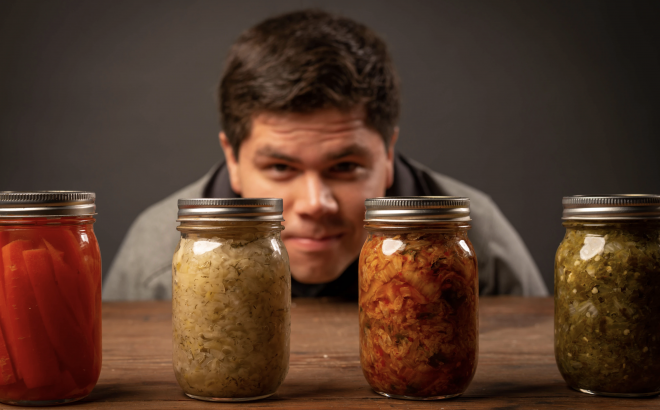Flavorful, crunchy home-made sauerkraut is easy to make at home.
Cool weather is best for putting up sauerkraut, so now is the time to chop up some cabbage and go for it. Like our Middle-Eastern preserved lemons, sauerkraut ferments in brine. According to fermentation guru Sandor Katz, whose book we reviewed here, brined foods boost immunities and may even have anti-carcinogenic properties. He used natural fermentation to stop HIV from hurting his body.
We claim that fermented foods can heal your gut. And if you like to eat sauerkraut anyway, you’ll enjoy the fresh, un-canned taste and crunchy texture of the jar you put up yourself. Sauerkraut is easy to make and takes hardly any time.
Home-made sauerkraut recipe
Large bowl
1-gallon jar or crock
Jar with 1 liter/ 1 quart capacity
Something to weigh the sauerkraut down while it’s fermenting: a plate that fits inside your jar or a Ziploc bag filled with water
Clean kitchen towel
Ingredients for sauerkraut
2 kg. – 5 lb. fresh cabbage, white, red, or a mixture
3 tablespoons salt – sea salt is healthiest, but plain table salt will do.
Cut the cabbages in halves and cut the cores out.
Method for making sauerkraut

Miriam’s homemade sauerkraut.
Chop the cabbage finely, scooping it into the bowl as you chop. Sprinkle salt in between the layers.
When all the cabbage is chopped and salted, mix it well and pack it into the 1-gallon jar. Push it down hard, using a wooden spoon, potato masher or your clean fist.
Place a clean plate or weight inside the jar to keep the cabbage tightly packed.
Cover with the kitchen towel.
The cabbage will begin to release juice almost immediately, but it takes about a day for enough liquid to form to cover the vegetable. You will need to press it down again every so often to encourage the liquid to release. If the cabbage isn’t covered with brine by the next day, make a simple cold brine of 1 cup water/1 tablespoon salt and add it to the jar.
Check the jar every day and push the cabbage down if needed. It will reduce in volume. Once you’re sure that it will fit , repack it into your smaller jar. As with all fermenting things, the less contact with air, the less chance of spoilage.
Start tasting after a week’s fermentation, and serve whenever you feel that the taste is right. Refrigerate. Pack the cabbage back down every time you remove some, and make sure that the object weighing it down is clean. Replace brine if needed.
That’s it! Enjoy!
Serving suggestion: Boil unpeeled potatoes and heat the sauerkraut. Place both, hot, in the same bowl and drizzle melted butter over all. A real rustic treat.
Recipes for making more pickled and sour stuff :
Sweet and Tangy Cucumber Chips




